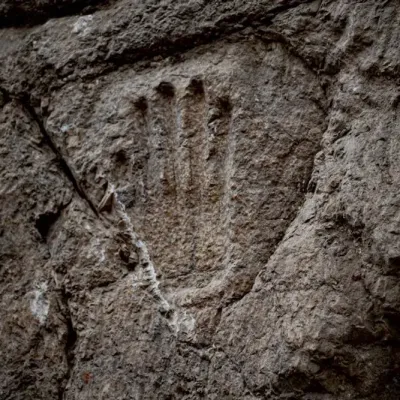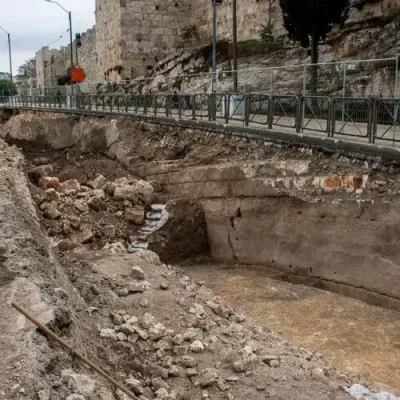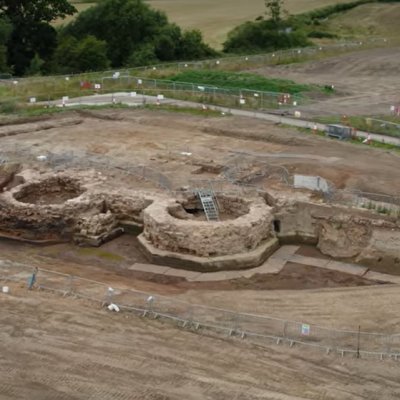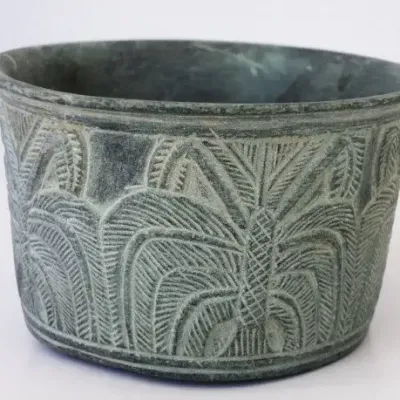INSTITUT SUPERIEUR D'ANTHROPOLOGIE
INSTITUTE OF ANTHROPOLOGY
ONLINE COURSES / COURS A DISTANCE
DEBUT COURS : FEVRIER 2023
REGISTER NOW
EGYPTE –  Louxor - L'Egypte a annoncé mardi 24 janvier la découverte à Louxor, la Thèbes des pharaons dans le sud, de vestiges d'"une ville romaine entière" datant des premiers siècles après Jésus-Christ. Il s'agit, selon le ministère des Antiquités, d'"une ville résidentielle entière" du IIe et IIIe siècle, découverte "sur la rive est du Nil, à proximité du temple de Louxor", à environ 500 km au sud du Caire. Dans cette "extension de la Thèbes antique", ont déjà été mis au jour "des ateliers métallurgiques" avec de nombreux outils et des "pièces de monnaie romaines en cuivre et en bronze", explique Mostafa Waziri, patron des Antiquités : "Et les fouilles se poursuivent".
Louxor - L'Egypte a annoncé mardi 24 janvier la découverte à Louxor, la Thèbes des pharaons dans le sud, de vestiges d'"une ville romaine entière" datant des premiers siècles après Jésus-Christ. Il s'agit, selon le ministère des Antiquités, d'"une ville résidentielle entière" du IIe et IIIe siècle, découverte "sur la rive est du Nil, à proximité du temple de Louxor", à environ 500 km au sud du Caire. Dans cette "extension de la Thèbes antique", ont déjà été mis au jour "des ateliers métallurgiques" avec de nombreux outils et des "pièces de monnaie romaines en cuivre et en bronze", explique Mostafa Waziri, patron des Antiquités : "Et les fouilles se poursuivent".
Egypte : découverte près de Louxor d'une "ville romaine entière" datant des IIe et IIIe siècles après Jésus-Christ (msn.com)
https://www.france24.com/en/live-news/20230124-egypt-archaeologists-uncover-complete-roman-city
ISRAEL – 
 Jerusalem - The Israel Antiquities Authority (IAA) discovered a deep 1,000-year-old rock-hewn moat and a mysterious hand imprint during excavations near the walls of Jerusalem’s Old City. Archaeologists believe their findings are elements of ancient Jerusalem's fortifications. “In the course of the excavations, part of a deep defensive moat that surrounded the city walls, probably dating from the tenth century CE and possibly earlier, were exposed. An unexplained carved hand imprint was discovered at one spot carved in the moat wall,” IAA’s statement said. The moat is located just underneath the main Sultan Suleiman Street that runs adjacent to the city walls. It was uncovered by Zubair Adawi, IAA excavation director.“People are not aware that this busy street is built directly over a huge moat, an enormous rock-hewn channel, at least 10 m wide, and between 2–7 m deep. The moat, surrounding the entire Old City, dates back about 1,000 years to the 10th century CE or earlier, and its function was to prevent the enemy besieging Jerusalem from approaching the walls and breaking into the city,” he explained. According to its width and depth, the moat was used as an “obstacle slowing down the attacking army.”
Jerusalem - The Israel Antiquities Authority (IAA) discovered a deep 1,000-year-old rock-hewn moat and a mysterious hand imprint during excavations near the walls of Jerusalem’s Old City. Archaeologists believe their findings are elements of ancient Jerusalem's fortifications. “In the course of the excavations, part of a deep defensive moat that surrounded the city walls, probably dating from the tenth century CE and possibly earlier, were exposed. An unexplained carved hand imprint was discovered at one spot carved in the moat wall,” IAA’s statement said. The moat is located just underneath the main Sultan Suleiman Street that runs adjacent to the city walls. It was uncovered by Zubair Adawi, IAA excavation director.“People are not aware that this busy street is built directly over a huge moat, an enormous rock-hewn channel, at least 10 m wide, and between 2–7 m deep. The moat, surrounding the entire Old City, dates back about 1,000 years to the 10th century CE or earlier, and its function was to prevent the enemy besieging Jerusalem from approaching the walls and breaking into the city,” he explained. According to its width and depth, the moat was used as an “obstacle slowing down the attacking army.”
https://www.i24news.tv/en/news/israel/archeology/1674636130-archeologists-discover-1-000-year-old-moat-mysterious-hand-imprint-in-jerusalem
ANGLETERRE – 
 Coleshil - Archaeologists excavated a site in Coleshill where they knew a medieval manor was located, according to a news release from Wessex Archaeology on Saturday, Jan. 21. Records of the Coleshill Manor are limited and marked with violence. The estate was built around the 14th century. The “magnificent” manor changed ownership in the late 15th century after the previous owner was “hung, drawn and quartered for treason,” archaeologists said. Excavations at the manor unearthed an “unexpected” and “monumental” structure: a large gatehouse. Ruins of the fortified building showed two octagonal rooms, likely the foundations of larger towers, historian Alice Roberts said in the release. Looking closer at the ruins, archaeologists found about 200 bullet marks left by pistols and muskets. Buried in the now-gone moat, they found 40 used bullets — evidence the gatehouse came under fire. The pockmarks may have been left during routine target practice, Roberts said. “But there’s also an intriguing possibility that we’re looking at evidence of the earliest skirmish of the Civil War.” The English Civil Wars, a period from 1642 to 1651, stemmed from conflict between supporters of the monarchy and parliamentary opposition groups in England, Scotland and Ireland, according to Britannica. The war replaced the monarchy with the Commonwealth of England. The first known battle of the English Civil War took place “only a short distance from Coleshill manor,” researchers said in the release. Advancing groups may have passed the manor and its strategic position next to a bridge over the River Cole.
Coleshil - Archaeologists excavated a site in Coleshill where they knew a medieval manor was located, according to a news release from Wessex Archaeology on Saturday, Jan. 21. Records of the Coleshill Manor are limited and marked with violence. The estate was built around the 14th century. The “magnificent” manor changed ownership in the late 15th century after the previous owner was “hung, drawn and quartered for treason,” archaeologists said. Excavations at the manor unearthed an “unexpected” and “monumental” structure: a large gatehouse. Ruins of the fortified building showed two octagonal rooms, likely the foundations of larger towers, historian Alice Roberts said in the release. Looking closer at the ruins, archaeologists found about 200 bullet marks left by pistols and muskets. Buried in the now-gone moat, they found 40 used bullets — evidence the gatehouse came under fire. The pockmarks may have been left during routine target practice, Roberts said. “But there’s also an intriguing possibility that we’re looking at evidence of the earliest skirmish of the Civil War.” The English Civil Wars, a period from 1642 to 1651, stemmed from conflict between supporters of the monarchy and parliamentary opposition groups in England, Scotland and Ireland, according to Britannica. The war replaced the monarchy with the Commonwealth of England. The first known battle of the English Civil War took place “only a short distance from Coleshill manor,” researchers said in the release. Advancing groups may have passed the manor and its strategic position next to a bridge over the River Cole.
https://www.charlotteobserver.com/news/nation-world/world/article271523272.html#storylink=c
IRAN - 
 Jiroft - Archaeologists found the ruins of a stoneware workshop estimated to date back to the 3rd millennium BC, during their excavations at Jiroft in Iran’s Kerman Province. A team of archaeologists from the University of Tehran has discovered a wide variety of stone vessels and stone ornamentations from the site of Hajjiabad-Varamin in Jiroft, IRNA reported. According to the archaeologists, stone containers and objects that were used or broken by people were not discarded in Jiroft, but their broken pieces were brought to the production workshop to make smaller containers and objects such as beads and pendants. The Jiroft culture also referred to as the Intercultural style or the Halilrud style is a presumed early Bronze Age (late third millennium BC) archaeological culture that was present in the region of the modern Iranian provinces of Sistan and Baluchestan and Kerman.
Jiroft - Archaeologists found the ruins of a stoneware workshop estimated to date back to the 3rd millennium BC, during their excavations at Jiroft in Iran’s Kerman Province. A team of archaeologists from the University of Tehran has discovered a wide variety of stone vessels and stone ornamentations from the site of Hajjiabad-Varamin in Jiroft, IRNA reported. According to the archaeologists, stone containers and objects that were used or broken by people were not discarded in Jiroft, but their broken pieces were brought to the production workshop to make smaller containers and objects such as beads and pendants. The Jiroft culture also referred to as the Intercultural style or the Halilrud style is a presumed early Bronze Age (late third millennium BC) archaeological culture that was present in the region of the modern Iranian provinces of Sistan and Baluchestan and Kerman.
https://arkeonews.net/5000-year-old-stoneware-workshop-found-in-iran/
MEXQUE – Tabasco - Archaeologists recently discovered two-meter-high domestic housing platforms made of clay in the Mexican state of Tabasco, indicating that there was once a pre-Hispanic Mayan settlement there. The archaeologists from the National Institute of Anthropology and History (INAH) were working on the site of a future oil and gas pipeline located between two existing archeology sites: Huimango and Comalcalco. The archaeological team has detected a considerable concentration of ceramic materials in the final section of the route, which is why it will also be excavated. Coordinator José Luis Romero Rivera reported that the new findings, named “Tintal,” were not registered among the 1,730 existing sites in the Archaeological Atlas of Tabasco, and further work was needed to determine the design of the area. “At the moment, we do not have enough knowledge to confirm that it is a single settlement three kilometers long, coinciding with the project route, or if there are two small sites,” he said. Rivera said further exploration of the site will increase its recognition and protection of the cocoa-rich Chontalpa region, which peaked between 600 and 900 AD in the Late Classical period.
https://www.artnews.com/art-news/news/pre-hispanic-mayan-housing-found-tabasco-1234654834/
ITALIE –  Rome - In an attempt to find the first section of one of the oldest avenues in Rome, a team of archaeologists on Tuesday announced they had stumbled upon several ancient objects that were buried in front of the Baths of Caracalla. Among the recovered objects is a marble bust of a male dating to the 2nd century AD, a rare coin from the year 700, a bronze ring with a monogram from the 6th century, as well as other everyday objects. The project sought to locate the first section of the Appian Way, one of the main roads of Ancient Rome, which some historical documents set at eight meters deep in front of the Baths of Caracalla. The Baths of Caracalla (circa AD 212 – 217) were one of the Ancient city’s largest public baths, which were built by order of Emperor Caracalla. They collected filtered water from two of the mountains near Rome. The discovered objects were found inside buildings from various periods of the city’s history: the oldest dates back to the reign of Emperor Hadrian, in the early 2nd century, while the most recent belongs to the modern age.
Rome - In an attempt to find the first section of one of the oldest avenues in Rome, a team of archaeologists on Tuesday announced they had stumbled upon several ancient objects that were buried in front of the Baths of Caracalla. Among the recovered objects is a marble bust of a male dating to the 2nd century AD, a rare coin from the year 700, a bronze ring with a monogram from the 6th century, as well as other everyday objects. The project sought to locate the first section of the Appian Way, one of the main roads of Ancient Rome, which some historical documents set at eight meters deep in front of the Baths of Caracalla. The Baths of Caracalla (circa AD 212 – 217) were one of the Ancient city’s largest public baths, which were built by order of Emperor Caracalla. They collected filtered water from two of the mountains near Rome. The discovered objects were found inside buildings from various periods of the city’s history: the oldest dates back to the reign of Emperor Hadrian, in the early 2nd century, while the most recent belongs to the modern age.
https://www.laprensalatina.com/ancient-objects-found-near-romes-baths-of-caracalla/
FRANCE –  Sens - Démarrée sur le terrain en mai 2022, la fouille de Sens Senigalia (140 av. Senigalia) touche tout un quartier urbain antique, encore inconnu sur la limite sud de la cité, occupé principalement entre le Ier et le IIIe siècle après J.-C. La proximité de la nappe alluviale (à la confluence de la Vanne et de l'Yonne) et son affleurement dans les niveaux antiques inférieurs a engendré de nombreuses difficultés pour la fouille, mais a fait du site un exceptionnel conservatoire des éléments organiques et des structures en creux de toutes périodes. Ont été notamment mis au jour 15 puits, dont ceux déjà étudiés ont livré, outre une très grande abondance de céramiques, une bonne quantité de restes organiques : bouchon d'herbes, cuir, bois et assises en bois de fond de cuvelage de ces puits. Les cuvelages de bois de nombreuses latrines de forme carrée ont été également découverts. L'étonnante concentration de ces latrines (24 sur l'ensemble du site) soulève la question de savoir si certaines d'entre-elles n'ont pas contribué à des processus artisanaux (tannerie ?). Dans tous les cas, ces différents aménagements se révèlent extrêmement riches en restes organiques et bois travaillés et ils ont livré, outre de nombreuses céramiques et de la faune, un lot de flans de fausse monnaie en cours de fabrication, des restes de vaisselle en étain et de rares fragments de tablettes à écrire en bois, portant des traces d'inscription à l'encre. Ces tablettes devaient être particulièrement répandues dans l'Antiquité, bien que seule une infime partie soit parvenue jusqu'à nous. Les analyses paléobotaniques, palynologie (pollens), carpologie (graines), xylologie (bois), entomologiques et paléoparasitologiques, permettent d'entrevoir la restitution d'un quartier antique de l'agglomération antique, sa mise en place progressive (sur un espace agraire tardo laténien, puis à proximité de la voie Agrippa), son agencement, son architecture, les activités qui y étaient menées, l'état sanitaire des populations qui y vécurent.
Sens - Démarrée sur le terrain en mai 2022, la fouille de Sens Senigalia (140 av. Senigalia) touche tout un quartier urbain antique, encore inconnu sur la limite sud de la cité, occupé principalement entre le Ier et le IIIe siècle après J.-C. La proximité de la nappe alluviale (à la confluence de la Vanne et de l'Yonne) et son affleurement dans les niveaux antiques inférieurs a engendré de nombreuses difficultés pour la fouille, mais a fait du site un exceptionnel conservatoire des éléments organiques et des structures en creux de toutes périodes. Ont été notamment mis au jour 15 puits, dont ceux déjà étudiés ont livré, outre une très grande abondance de céramiques, une bonne quantité de restes organiques : bouchon d'herbes, cuir, bois et assises en bois de fond de cuvelage de ces puits. Les cuvelages de bois de nombreuses latrines de forme carrée ont été également découverts. L'étonnante concentration de ces latrines (24 sur l'ensemble du site) soulève la question de savoir si certaines d'entre-elles n'ont pas contribué à des processus artisanaux (tannerie ?). Dans tous les cas, ces différents aménagements se révèlent extrêmement riches en restes organiques et bois travaillés et ils ont livré, outre de nombreuses céramiques et de la faune, un lot de flans de fausse monnaie en cours de fabrication, des restes de vaisselle en étain et de rares fragments de tablettes à écrire en bois, portant des traces d'inscription à l'encre. Ces tablettes devaient être particulièrement répandues dans l'Antiquité, bien que seule une infime partie soit parvenue jusqu'à nous. Les analyses paléobotaniques, palynologie (pollens), carpologie (graines), xylologie (bois), entomologiques et paléoparasitologiques, permettent d'entrevoir la restitution d'un quartier antique de l'agglomération antique, sa mise en place progressive (sur un espace agraire tardo laténien, puis à proximité de la voie Agrippa), son agencement, son architecture, les activités qui y étaient menées, l'état sanitaire des populations qui y vécurent.
https://www.inrap.fr/sens-retrouvee-par-l-archeologie-preventive-yonne-17024
BELGIQUE - Roulers - Les archéologues ont fait plusieurs découvertes archéologiques datant de la période romaine et du Moyen Âge à Roulers. L'étude archéologique en cours a mis au jour des vestiges de l'époque romaine et du Moyen Âge. Un certain nombre de traces de fondations, un fossé, un four à charbon de bois et un tombeau contenant des restes brûlés avec des jarres en céramique ont été retrouvés. Ils prouvent l'existence d'activités et d'habitations qui remontent à l'époque romaine. Plusieurs fossés et fosses peuvent aussi être associés au Moyen Âge, entre le Xe et le XIIe siècle. "Ensemble, ils nous donnent un meilleur aperçu de l'histoire des habitations et de l'implantation paysagère des activités qui ont eu lieu sur le hameau de De Ruiter dans le passé. Dans une perspective plus large, ils contribuent à une meilleure compréhension de l'évolution de la vallée du Mandel vers ce qu'elle est devenue aujourd'hui", affirment les archéologues.
https://www.rtl.be/actu/regions/flandre/des-decouvertes-archeologiques-de-lepoque-romaine-et-du-moyen-age-roulers/2023-01-23/article/518907
TUNISIE –  Radès - Les fouilles de sauvetage en cours sur le site de l’église de Radès qui sont menées par des experts de l’Institut national du patrimoine (INP) ont permis la découverte de citernes datant des époques punique et carthaginoise. L’équipe de recherche de l’INP s’est lancée en décembre dernier, dans une fouille de sauvetage suite à la découverte archéologique de plusieurs citernes romaines susceptibles d’avoir fait partie des monuments de la ville romaine de Maxula.
Radès - Les fouilles de sauvetage en cours sur le site de l’église de Radès qui sont menées par des experts de l’Institut national du patrimoine (INP) ont permis la découverte de citernes datant des époques punique et carthaginoise. L’équipe de recherche de l’INP s’est lancée en décembre dernier, dans une fouille de sauvetage suite à la découverte archéologique de plusieurs citernes romaines susceptibles d’avoir fait partie des monuments de la ville romaine de Maxula.
https://africanmanager.com/decouverte-de-citernes-datant-des-epoques-punique-et-carthaginoise-sur-le-site-de-leglise-de-rades/